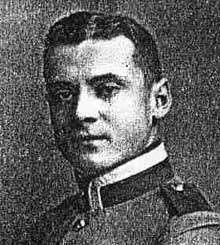Albert Mayer (soldier)
Albert Mayer (24 April 1892 – 2 August 1914) was the first German soldier to die in World War I. He died one day before the German Empire formally declared war on France.[1]
Albert Otto Walter Mayer | |
|---|---|
 | |
| Born | April 24, 1892 Magdeburg, Saxony-Anhalt, German Empire |
| Died | August 2, 1914 (aged 22) Joncherey, France |
| Buried | German Military Cemetery, Alsace, France |
| Allegiance | German Empire |
| Service/ | Imperial German Army |
| Years of service | 1912–14 |
| Rank | Leutnant |
| Unit | Jäger Regt-zu-Pferd Nr 5, 29th Cavalry Brigade, 29th Cavalry Brigade, 29th Infantry Division |
| Battles/wars | Skirmish at Joncherey |
Early life
Albert Otto Walter Mayer was born on 24 April 1892, at Magdeburg, in Saxony-Anhalt. His family had moved to the area of Mulhouse, Alsace when he was a boy. He enlisted into the Imperial German Army in 1912. In August 1914 he was a Leutnant in his local cavalry unit - the Jäger Regt-zu-Pferd Nr 5, which was part of the 29th Cavalry Brigade of the 29th Infantry Division, garrisoned in Mulhouse.[2]
Death
During the morning of 2 August 1914 a cavalry patrol led by Leutnant Mayer crossed into France before war had been officially declared. Upon entering French territory it was confronted by a French Army sentry, whom Mayer attacked and wounded with his sabre. Around 9.30 A.M. the German patrol entered the village of Joncherey. French soldiers billeted nearby were notified and deployed to confront the German intruders. At 10 A.M. Corporal Jules-André Peugeot, leading the French troops saw the German force and shouted a command to stop as they were under arrest, to which Mayer pulled out his pistol and shot at Peugeot, mortally wounding him in the shoulder. Peugeot, in turn, fired his weapon at Mayer but missed. Other soldiers of Peugeot's detachment then opened fire at the Germans, hitting Mayer in the stomach and head, killing him, with the remainder of the German patrol riding away from the scene. Mayer's body was buried in Joncherey the next day. The body was later removed to the German military cemetery at Illfurth near Mulhouse, where his gravestone is marked with the inscription ‘1st German Casualty of the World War 1914-18'. His helmet was retrieved by the French authorities, and today is on display at the Musée de l'Armée in Paris.[3]
See also
- Jules Andre Peugeot, the first French Army soldier killed, 1914
- John Parr, the first British Army soldier killed, 1914
- Thomas Enright, one of the first three American Army soldiers killed, 1917
- Merle Hay, one of the first three American Army soldiers killed, 1917
- James Bethel Gresham, one of the first three American Army soldiers killed, 1917
- George Edwin Ellison, the last British Army soldier killed in World War I, at 9:30 a.m. 11 November
- Augustin Trébuchon, last French soldier killed, at 10:45 a.m. 11 November
- George Lawrence Price, last Commonwealth soldier killed in World War I, 10:58 a.m. 11 November.
- Henry Gunther, last soldier killed in World War I, at 10:59 a.m. 11 November.
References
- http://www.westernfrontassociation.com/great-war-people/brothers-arms/1515-the-first-to-fall-peugeot-and-mayer-2-august-1914.html#sthash.a5F3cQIv.UpNrqEtO.dpbs
- http://www.westernfrontassociation.com/great-war-people/brothers-arms/1515-the-first-to-fall-peugeot-and-mayer-2-august-1914.html#sthash.a5F3cQIv.UpNrqEtO.dpbs
- http://www.findagrave.com/cgi-bin/fg.cgi?page=gr&GScid=2391027&GRid=66337082&